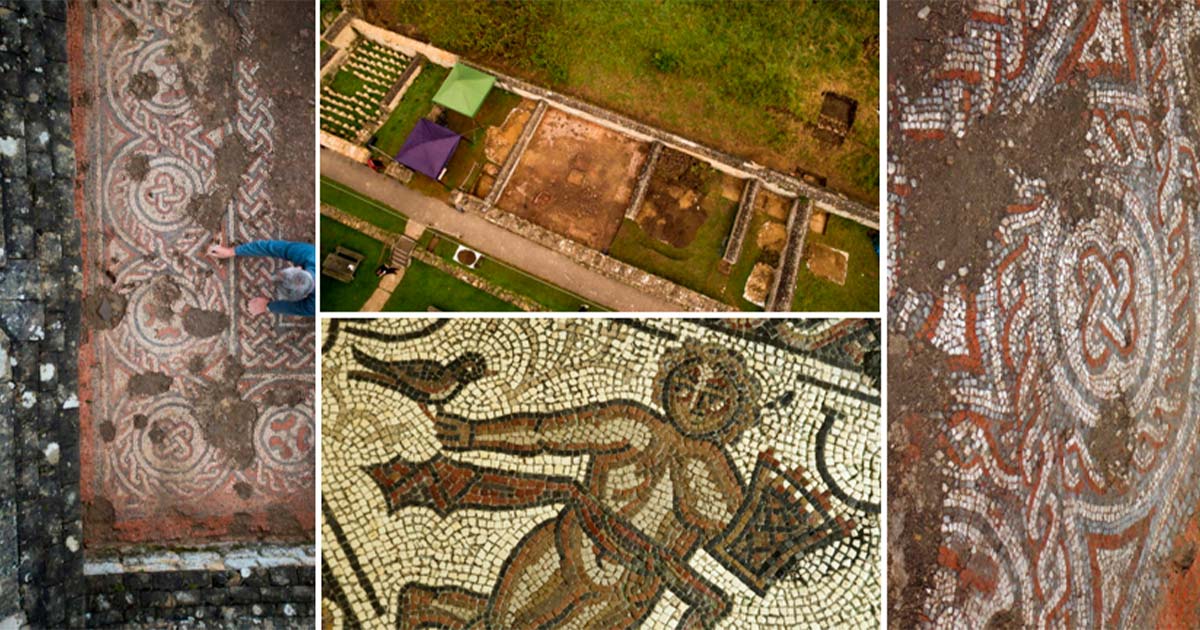Roman Mosaic Date Brightens Up Britain’s Dark Ages in More Ways Than One
Rome wasn’t built in a day, but it’s popularly believed that its fall to ‘barbaric’ forces by the beginning of the 5th century, plunged all of Europe into a ‘Dark Age’, where towns and villas experienced a rapid decline. But Chedworth’s Roman Villa in England has changed that thinking, as it is now confirmed as home to a mosaic created in the mid-5th century, reinforcing the belief that sophisticated living did not die a death with Rome’s decline after 410 AD.
A Luxuriated Existence: Life After Rome?
The scientific investigation centered on a mosaic within Chedworth Roman Villa in Gloucestershire, exposing a persistent Romanized way of life, particularly in the West Country. Dating back to the 2nd century AD, Chedworth boasts numerous historically significant features, including a water shrine, bathhouses, a latrine, a kitchen, hypocaust systems, and an extensive collection of artifacts, reports The National Trust.
- Artifact-Rich Ancient Roman Village Unearthed By UK Archaeologists
- Roman Villa Unearthed in Northern Yorkshire is First of its Kind

The Chedworth Roman villa site where the mosaic (to the right of the tent coverings) was found. (© National Trust Images)
A New Date Emerges
In 2017, a charcoal sample extracted from the foundation trench of a wall from room 28, incorporating the mosaic at Chedworth, underwent radiocarbon dating. This scientific test, utilizing the decay of a radioactive carbon isotope to estimate age, yielded a surprising result—indicating that the earliest possible construction date for the mosaic was 424 AD!
This finding challenges the initial assumption that the mosaic was of Roman origin, suggesting instead that it was crafted during the Early Medieval period. According to National Trust archaeologist Martin Papworth, “Our whole vision of this society is wrong.”
The evidence of this mosaic points to a more gradual decline. The establishment of a new room and the installation of a new floor suggest ongoing wealth and the continuity of a mosaic industry 50 years later than initially anticipated.
The unexpected 5th-century date prompted further scrutiny which has just been completed. In consultation with the Trust's expert advisors, a second radiocarbon date, in conjunction with pottery analysis, was deemed necessary for a comprehensive understanding and validation of this remarkable discovery.
- Boudicca: The Celtic Queen Who Unleashed Fury on the Romans
- Sacred Britannia: The Gods and Rituals of Roman Britain
Challenging the Notion of the Dark Ages: A Gradual Decline
In addition to radiocarbon dating and pottery analysis, archaeologists utilized Optically Stimulated Luminescence (OSL) to determine when the soil beneath the tiles was last exposed to sunlight, reports The Daily Mail.
Papworth underscored the use of OSL, along with new radiocarbon dates, as conclusive evidence supporting the mosaic's dating to the 5th century. This revelation challenges the traditional understanding of the 'Dark Ages' as a period marked by economic, intellectual, and cultural decline.
Martin explained that archive material suggests that with the Roman Empire’s collapse in Britain around 410 AD, a general regression of society occurred. The prevailing belief suggests that the majority of the population resorted to subsistence farming, leading to a breakdown of Britannia's administrative system into local fiefdoms. The evidence from the ground, however, suggests a different picture altogether.

An archaeologist working on the Chedworth Roman villa mosaic that has changed the view of post-Roman history in the UK. (Stephen Haywood/© National Trust Images)
He pointed out that there were scarce historical fragments indicating the persistence of a Romanized way of life, particularly in the West Country. The East of Britain, closer to Germany and Holland, experienced a more rapid decline in Romanization. Nevertheless, the West Country, encompassing Gloucestershire, Dorset, and Somerset, seemed to resist the Saxon advance.
Martin suggested that it seemed more likely that these areas continued with their normal way of life, gradually winding down, rather than undergoing a sudden collapse.
The radiocarbon dating results suggested the presence of someone wealthy enough to commission a new mosaic for their home two or three generations after conventional beliefs indicated that the entire country had collapsed, and everyone was living in shacks. Clearly, a fairly sufficient trade economy was in place rather than a mere hand-to-mouth bartering system.
Professor Alice Roberts described the discovery as “mind-blowing”. She said:
“This is so exciting and it's unlikely to be unique. It's unlikely this is the only villa that carries on into the fifth, maybe sixth centuries. We have to go back and look at all the rest. It's one of those times when we can genuinely say, this is re-writing history.”
Top image: Various shots of the mosaic now confirmed dated to the 5th century at Chedworth Roman Villa. Source: Stephen Haywood/Ian Shaw/ © National Trust Images
By Sahir Pandey
References
Best, S. 2024. Rewriting the history of life in Britain after the Roman Empire: 5th century mosaic at a villa in Gloucestershire proves sophisticated life continued long into the Dark Ages, experts say. Available at: https://www.dailymail.co.uk/sciencetech/article-12973799/Britain-Roman-Empire-mosaic-dark-ages.html.
Bunn, G. 2024. Roman Empire found to have stretched long into Dark Ages as history of early Britain rewritten. Available at: https://www.gbnews.com/news/roman-empire-history-dark-ages-early-britain-rewritten.
Davis, M. 2024. Chedworth Roman Villa's 5th Century Mosaic Challenges Assumptions, Unveils Sophisticated Life Beyond the Roman Era. Available at: https://www.sciencetimes.com/articles/48238/20240118/chedworth-roman-villas-5th-century-mosaic-challenges-assumptions-unveils-sophisticated.htm.

















